How a Differential works ?
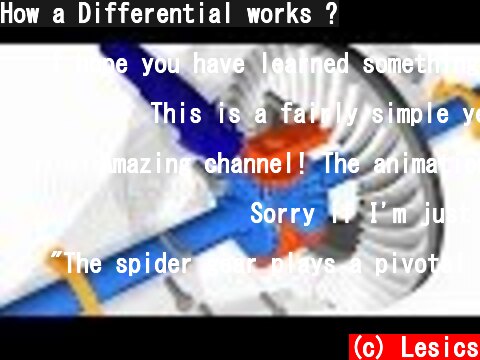
(c) Lesics Help us to make future videos for you. Make LE’s efforts sustainable. Please support us at Patreon.com …
I hope you have learned something new today. Please support us at https://www.patreon.com/LearnEngineering . Your support keeps us going.
This is a fairly simple yet absolutely genious form of engineering
Amazing channel! The animations really help me understand in depth without any confusion. I’m really thankful channels like this exist so I can learn from home
Sorry if I’m just being really stupid, but how does the spider gear “know” to rotate on its own axis when the car is turning? Or is there some sort of mechanism involved?
“The spider gear plays a pivotal role here”Well played.
Its amazing how complex that helical gear design is .. And all the movement, same as transmissions and synchromesh Long way since the horse and carriage
You guys are the best in the business and concisely explaining complex mechanical engineering to simpletons such as myself. Bless your hearts.
Wow. I mean wow. I always thought cars were relatively simple, I mean they were the first vehicle ever invented and car mechanics are usually blue collar workers. But this stuff blows my mind. I’ve been learning how cars work the past hour and it keeps blowing my mind, but this… the differential… I am amazed. I am also embarrassed to think I could not have thought of such a good mechanism that was also so simple. Come to think of it, I wouldn’t even think about the wheels needing to rotate at different speeds. Amazing, it corrects itself purely mechanically. Cars are freaking amaziiiiiiiiiiiiiiiiiiiiiiiiiiiiiing……
“Differential plays an integral part”, this made me laugh.
Perfectly explained sir. Thank you for making such animation video for us to understand basic concept easily.
One of the concepts that really benefits from animated video. For those people still baffled, I share that sometimes – the person who thought this up is sort of a genius but ignored the issue of traction on poor and variable surfaces. Here’s my short version: In a STRAIGHT LINE travel situation, you can treat the ‘spider’ gear(s) (the little bevel gear mounted on a bar from the biggest or ‘ring’ gear) as simply LOCKED to both axle-end gears, as if welded. IE in a straight line, perfect surface traction, the twiddly bits in the middle are locked up in effect. DURING A TURN – or of course if one wheel slips in mud and the other is stuck solid ! – the trick is to realise that the little spider gear is going to ‘lean on’ whichever axle-end gear is the most steady (the stuck wheel axle), and spins against that to drive the axle-end gear it can. This situation means the little spider gear NECESSARILY drives it’s way along the ‘stuck’ side, and TURNS THE FREE-SPINNING AXLE-END GEAR and thus the axle IN TWO WAYS – ONE with the spinning of the little spider gear about it’s OWN axis or pivot, but TWO is the fact that the spider itself while doing this, is entirely rotated along with it’s axis/bearing/bar that supports it, AS WELL.That, ladies and gentlemen, is why NOT ONLY does the free-spinning wheel on a differential axle freely spin, BUT SPINS at TWICE the speed that the wheels would if only both of the frickin’ things would turn together! Hopeless. As ‘LEarn’ point out in the next video about Limited Slip Diffs, this is the major drawback. It’s such a massive flaw even for occasional grassy-field parking, it’s a wonder nothing was generally done about it for decades, the reason of course is that every tinker you do to this blessed thing, results in a headache you have to solve. My solution? Electric motors in every wheel and electronically control the relative speed to be theoretically correct. Every vehicle then is AWD and regen braking is guaranteed, and the wheels that spin only are turned as software dictates – eg at exactly the same speed as any other wheel if you are on snow/ice, so basically it will impose driving in a straight line while providing the maximum grip – the rest is down to tyres. You could even turn corners without turning the steering, by making one side of wheels go faster than the other. Still, good vid. It’s not an easy concept to get your head around, despite drawbacks, whoever thought of it was a genius.
Finally, Now i understood the real working by this video in just single look. Thanks a lot to the animators, maestro and team.
So I loved this video. I know the comments are old but I needed to try to clarify things for myself and maybe others or at the very least be corrected by others.The left axle gear is always spinning clockwise (going forward) and the right axle gear is always spinning counter clockwise and when the car is proceeding forward in a straight direction both axle gears, while spinning in opposite directions, are rotating in the same direction and at the same velocity. When a turn is initiated, the outer wheels speed increases which creates the torque that drives the spider wheel to spin. The outer wheel is initiating the torque and the fact that the wheel axles are spinning opposite directions means there is is an opposing force of the inner axle gear, slowing it down.�Is this correct?My question is: is the inner wheel keeping its speed while the outer wheel has increased its speed or does the inner wheel actually slow down from the force? And is the force applied to the inner wheel actually a form of torque?Thx muchDan
This is great. I’ve always wondered how the gears in the differecial works.
Where would we be without the invention of gears! It’s amazing how precisely engineered they are that the teeth last for decades rubbing against each other.
Thank you so much for this video! This and the Limited Slip video explains EXACTLY what I wanted to know about differentials.
This video has been really helpful for me in understanding the role of differential gear in an automobile. Thanks a lot for such a good video.
Amazing! What software do you use to create such great animations?
Great video. Thanks for explaining that so clearly!
This is a great video! I understood it perfectly. Thanks for making it!
Understanding Wheel Alignment !
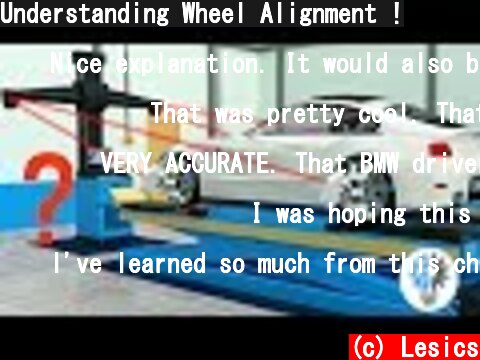
(c) Lesics After a certain running distance all the four wheelers are supposed to undergo the wheel alignment operation. What is wheel …
Nice explanation. It would also be interesting to learn how the wheel alignment tool works. I presume it is light based but don’t know the details. It would also be interesting to learn how alignment adjustments are made.
That was pretty cool. That’s essentially how this works. Been an alignment tech for some 35 years. It’s always a fight between tire wear and handling. People don’t understand that a performance car will go through tires faster. Such as a BMW.
VERY ACCURATE. That BMW driver didn’t signal while turning,n
I was hoping this would explain HOW the alignment system works to re-align your car after it has come out of alignment.
l’ve learned so much from this channel. NEVER stop uploading these types of visualized explanation videos.
Excellent video. Easy to understand, straight forward, educational. Ideally, I hope to know how the alignment is done, how many man-hours are required for the tuning and how long will the realigned tyres last before the driver needs to head back to the workshop again, the cost, and how many mishaps were caused by poorly aligned tyres in the past.
Thank you for this video. I’m hoping we come up with something that is safer and doesn’t require so much maintenance. I personally despise how often alignment is adversely affected by the very roads we build and also expensively maintain.
This is really interesting. As a mechanic/engineer myself, I was alway intrigued about perfect wheel alignment. But we used to do only front wheel alignment in the 60-70s. Independent suspension and all wheel drive vehicles came later, with the early Jaguar being the best known vehicles with independent suspension.
Thanks for sharing the knowledge! Can you please do a comprehensive video on all the shared platforms between different car models and manufactures? As this information is not easily accessible to general public; even if it is, it’s always bits and pieces. Appreciate the good work, Thanks!
Amazing as always. Thanks very much. This and the caster angle video have been very informative for me because I noticed some of the angles and wondered about it since some time.
Love the video. Really helped me understand how different alignments work. 👍🏻
Quite a complex lesson on geometry! It would be useful to know how a workshop aligns the wheels and rotates the tires for ensuring uniform wear of the tires.
Excellent engineering course ! Thanks so much !!!
Such an informative video. I will strongly recommend to all drivers.
Hey, the video explains the wheel alignment very well. I wanted to know if we are making a car for student formula competition, how should we decide the camber and caster angles?
Learned Automobile Engineering during college. But never learned this. Great insight LE. Keep it up!
Great clip, but I have a doubt: my instinct keeps saying to me that increasing the speed with a toe out setup could lead to understeer, so the statement “toe out=oversteer” (a little bit and below a certain limit), actually not always true. What am I missing?
Such an excellent explanation! Considering how many people drive and [hopefully] get regular alignment, this video just doesn’t have enough attention. Also would be great to see the actual procedure explained and what calibration factors affect the outcomes.
This is such a great and simple to understand video . Thank you so much!
This is what I have been looking for! Now I understand how to set my car in assetto corsa! Thank you
Seatbelt | How does it work?
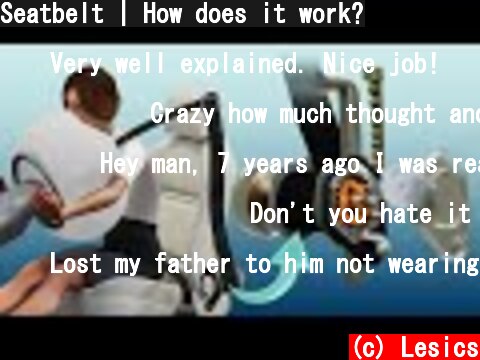
(c) Lesics Everybody knows what happens in an accident if you don’t wear a seatbelt. What you see in this accident looks really painful in …
Very well explained. Nice job!
Crazy how much thought and engineering goes into aparently simple things
Hey man, 7 years ago I was really wondering how this works. I couldn’t find anything on the internet that was accessible to me and even my physics teacher didn’t know. But I’m very proud to say that my 14 year old self figured out the part with the steel ball. Thank you for your animation, this was really interesting!!!
Don’t you hate it when there’s a massive boulder in the middle of the road
Lost my father to him not wearing his seatbelt, my life would have been much different if he would still be here. I don’t know why anyone wouldn’t wear a seatbelt your chances of surviving are so much greater.
I see forms of this question coming out multiple times in the comments: “Will the seat belt pretensioners fire in a sudden braking event?” Short Answer: No. Long answer: The video is mistaken, the pretensioners do not fire before an impact, the airbags and pretensioners fire when (depending on the system) the vehicle’s impact sensors are triggered and/or an accelerometer in the SRS module detects an impact. When the vehicle hits something, there is time between the initial impact and the vehicle coming to a complete stop. This time is the time in which the occupants of the vehicle must be safely decelerated from the vehicle’s pre-collision speed to a stop. The most serious accident is when a vehicle hits a stationary ‘non deformable’ object (such as the rock in the video). If the vehicle had a ‘rigid body’ chassis (term used in theoretical physics to mean undeformable) then the vehicle and occupants would have to decelerate to zero instantaneously, resulting in massive injury or death to the occupants. Obviously this is theoretical, and the chassis of the vehicle bends and deforms, all the while decelerating the passenger compartment and therefore the occupants (this is the reason for crumple zones, they are sacrificial components of the vehicle intended to absorb the energy of the vehicle and decelerate it at a rate that is more safe for the occupants. This increases the time from which the initial impact occurs to when the vehicle & occupants come to a stop. During this time after the initial impact, the SRS (Airbag) module uses accelerometers, in many cases additional ‘impact ‘ sensors, and occupant weight sensors (specific layouts vary from manufacturer to manufacturer and model to model) to compute the severity of the accident, determine which aribags/pretensioners to deploy and in some cases how quickly to deploy them (some aribags have multiple stage deployments) , all in fractions of a second (down to as little as 10ms in some cases) and before the force of the impact reaches the passenger compartment.Edit: Note some vehicles do not use ‘pyrotechnic’ pretensioners (pretensioners that use an explosive charge like the pretensioners described in this video). These Vehicles have different controls, and I am not familiar with these systems.
Is no one gonna talk about how much accidents she went in for us
This is amazing. I was surprised that a lot of mechanisms (more than I thought) are used in seat belt. Thank you a lot!!!
The three point seatbelt was invented or designed by volvo and they left it patent free so that every vehicle manufacturers can use it
The ball bearing is absolutely ingenious! Simplicity at its finest.
Hey, thanks for your informative illustration on a seat belt working. This uses the fundamental design of mechanical engineering. I studied gear and belt movements but your video shows its real-life application. Once again thanks for sharing knowledge in an animated way.
Incredible engineering design, the developer were appreciated.
so much thought into something as “simple” as a seat belt…awesome vid
she really didn’t see that boulder in the road tho?
Great explanation! Such an interesting combination of mechanisms. Thanks!
A huge thank you to the video content creators, very well explained.
Very interesting and well explained! Good job!. Now I’d love to know which cars and models have which type of seatbelts, so I can be sure they are indeed as safe as the latest shown.
Never in my lifetime would I figure out how to design something as simple as this
Fun fact:Volvo have electric pretensioners on newer cars. So the car can actually pretension the belt BEFORE an accident has happened. They also have, since long back, TWO explosive devices – one at the top mount (as shown here in the video, where the roll is) and one at the bottom mount (where it is fastened between the door and the seat). This is because this saves lives since it tension the belt in a better way.
Very good explanation, thank you! Only thing I disagree is the pre-tentioners don’t explode when braking hard but only when they detect actual crash. If it wasn’t like that they would be activated all the time by car journalists testing the brakes 🙂
Understanding STAR-DELTA Starter !
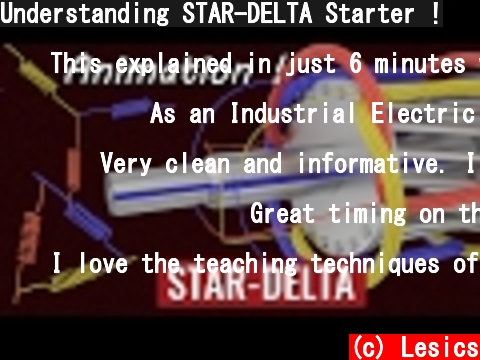
(c) Lesics You might have seen that in order to start a high power rating induction motor, a starting technique called star-delta is used. In this …
This explained in just 6 minutes what our professors couldn’t during the whole course. thanks a lot
As an Industrial Electrician, now retired, I learned this starter application many years ago during my apprentice training. Your video should make this very easy and clear for young guys starting out in this trade. Excellent job.
Very clean and informative. I learned this as part of energy efficiency course. Good job on both the explanation and animation!
Great timing on the video! I just did the measurements of starting current in both delta and star formation on an electrical engineering lab course.
I love the teaching techniques of this channel. Amazing 🙂
Amazing! Mind-blowing how you guys explain things so freaking wel! Thank you!
Very good explanation! Loving the animations too, very accurate.
This is a very effective explanation of a complex process using animation. It is a lot of work and I appreciate every second of it. Thank you!
One of the best engineering channels on youtube! Keep up the good work!
Thanks for the knowledge YOU SHARE and a very good presentation. GOD BLESS YOU MORE!
Great video, would love to see one of how a rotary converter works.
The best illustrative explanation on Youtube I could find. Thank you
I am an EE Engineer and no one has ever explained this crystal clear… Can see great efforts behind this video. Congratulations.. 👏
Also, I appreciate the animations as well as the pauses, that give time to process the info!!
5 years in hvac and no one has ever been able to explain that to me like you did in this video! Much appreciated
Bro I have seen tons of videos and even went to school for this. Your video is more valuable than all previous resources I have encountered. Great job man.
Thank you very much. The most clearest explanation I’ve ever seen. Animation makes it the best one.
Wow!! Really good job at explaining this concept and translating it into something more practical!! 👍👍
Awesome explanation sir. Thank you. I am electrical Engineer myself during 1987-1991, during this period I use to study through text books only. Thanks to the computer animation, even a layman can understand the concept.
You gave me such a fantastic insight how star-delta works. Many thanks 🙂
Understanding Hill Start Assist!
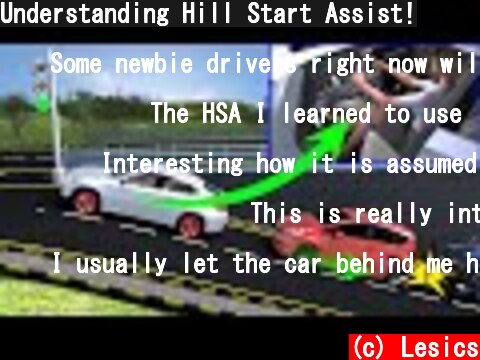
(c) Lesics Let’s understand the technology behind the hill start assist in a logical way. Be our supporter or contributor: …
Some newbie drivers right now will never experience the pressure when driving a manual and an uphill traffic occurs. Especially when you’re a beginner and you can feel your car rolling down and you can hear the honking of the car at the back😂
The HSA I learned to use is the clutch and parking brake.
Interesting how it is assumed that only automatic transmissions are used in cars. Outside the USA, that is often not the case.
This is really interesting! I’ve only driven manual cars, so assumed that automatics were holding the clutch partially engaged for you, rather than holding the brake on.
I usually let the car behind me hold my car in place.
Oldschool hand-brake technique left the chat..
I am european and there’s a pedal missing
There has been a technology that has been there for ages. it’s called a hand brake.
I used to do all this with my left foot on the brake or in a car with a clutch with the hand brake. A foot operated parking brake was a bit more problematic.
It doesn’t take seconds to switch between the pedals, just release the brake and quickly press the accelerator more than usual. The car doesn’t immediately start rolling back at full speed
A rachet mechanism is also a solution but brake system would have worked better hence is adopted. Great 👍
Now that I drive an EV, I am starting to remember how much I used to have to do with a manual. I wonder if I still have those skills? It’s been so long.
There is also handbrake available in every vehicle, one should use handbrake on when stopped on inclined road and when u want to move up again put ur foot on acceleration paddle and accelerate, when u feel it moving release handbrake and u r going up. Its simple (need Practice)
I would still prefer the handbrake technique. Its effective and fun.
The simplest way for good drivers is to use your left foot on the brake when you approach a hill start.
When I was learning, I had to accelerate, release the clutch slightly, feel the car’s momentum & then accelerate more & release the clutch fully & let the car move.
Wow they dont explain this that well when you buy a new car. They just tell you that the car has abs, hsa, hid, cbd, tbh, icu, pcu, tcc, abc, fox, sky, cnn and etc.
Also called “Hill Holder.” It was available on Studebakers and Subarus.
how do u struggle with hill starts in an automatic 💀
I passed my mannual driving exam 6 yrs ago.. a bit panic in hill area during my driving lesson .. but i passed!! Now i’m using automatic car without going to driving lesson.. great video 👍👍
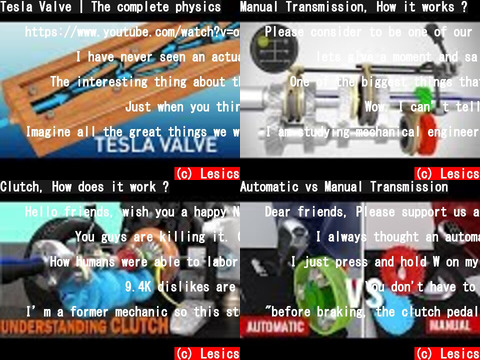













![岡田斗司夫 [切り抜き] 編集ちゃんねる(Youtube 動画 pick up)](https://imitoha.com/c/imgc/UCwfyW7i8kAFUj8_tSSDT_PA/-a-input.jpg)









コメント